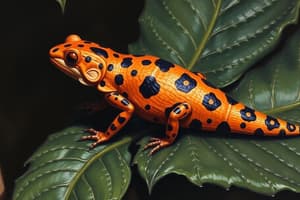Podcast
Questions and Answers
How does Mullerian mimicry differ from Batesian mimicry?
How does Mullerian mimicry differ from Batesian mimicry?
In Mullerian mimicry, two or more distasteful or dangerous species share similar traits to confuse potential prey, whereas in Batesian mimicry, a harmless species mimics the appearance of a harmful species to deter predators.
What is the purpose of Mullerian mimicry, and how does it serve as a warning signal to predators?
What is the purpose of Mullerian mimicry, and how does it serve as a warning signal to predators?
The purpose of Mullerian mimicry is to warn predators that the species involved should not be consumed due to their toxicity or distastefulness. By sharing similar traits, the species involved can present a unified warning signal to predators, reducing the likelihood of being attacked and consumed.
How does mimicry, in general, demonstrate the role of deception in natural selection?
How does mimicry, in general, demonstrate the role of deception in natural selection?
Mimicry demonstrates how deception plays a significant role in shaping the evolution of various species. By adopting the appearance or traits of other organisms, species can gain an advantage in terms of survival and reproduction, highlighting the complex interactions and adaptations within ecosystems.
Explain how Mullerian mimicry can be considered a form of cooperation between species.
Explain how Mullerian mimicry can be considered a form of cooperation between species.
How does the concept of Mullerian mimicry contribute to our understanding of the intricate web of relationships among living organisms and their environment?
How does the concept of Mullerian mimicry contribute to our understanding of the intricate web of relationships among living organisms and their environment?
Explain the concept of Mullerian mimicry and provide an example of species that exhibit this type of mimicry.
Explain the concept of Mullerian mimicry and provide an example of species that exhibit this type of mimicry.
Distinguish between perfect mimicry and imperfect mimicry in the context of predator-prey relationships.
Distinguish between perfect mimicry and imperfect mimicry in the context of predator-prey relationships.
Discuss how Batesian mimicry differs from Mullerian mimicry in terms of the species involved and the outcomes for predators.
Discuss how Batesian mimicry differs from Mullerian mimicry in terms of the species involved and the outcomes for predators.
Examine the potential advantages of imperfect mimicry over perfect mimicry for species survival.
Examine the potential advantages of imperfect mimicry over perfect mimicry for species survival.
Explain how Mullerian mimicry contributes to the evolutionary success of a group of species despite having distinct palatability levels.
Explain how Mullerian mimicry contributes to the evolutionary success of a group of species despite having distinct palatability levels.
Flashcards are hidden until you start studying
Study Notes
Mimicry: Deception in Nature
Understanding Mimicry
Mimicry, in biological terms, refers to the phenomenon where two or more organisms display striking similarities that confer a survival advantage upon one or both species. These resemblances enable organisms to protect themselves from predators, escape danger, or attract mates by confusing or deceiving other species. The concept of mimicry was first introduced in detail by Henry Walter Bates in the mid-19th century.
Types of Mimicry
There are several types of mimicry, each with distinct characteristics and advantages for the organisms involved:
Batesian Mimicry
Batesian mimicry occurs when a harmless organism gains protection from predators by resembling a toxic, distasteful, or otherwise unappealing species. This type of mimicry is named after Henry Walter Bates, who discovered it in Brazilian forest butterflies. In this scenario, the mimic benefits from the protection offered by the resemblance to the model, while the model enjoys reduced predation pressure due to being less attractive to predators. This type of mimicry typically involves three components: the model species, which is toxic or otherwise unappetizing; the mimic species, which gains protection by resembling the model; and the predator, which avoids consuming the models and their mimics.
Mullerian Mimicry
In contrast to Batesian mimicry, Mullerian mimicry occurs when two or more distasteful or dangerous species share similar traits to confuse potential prey. In this case, both the model and the mimic benefit from reduced predation pressure, as they are equally unpalatable to predators. The concept was named after the German zoologist Fritz Müller, who first described this phenomenon. Mullerian mimicry can serve as a warning signal to predators that the species involved should not be consumed due to their toxicity or distastefulness.
Conclusion
Mimicry is a crucial aspect of natural selection, demonstrating how deception plays a significant role in shaping the evolution of various species. It highlights the complex interactions between different organisms within ecosystems and offers valuable insights into the adaptive strategies employed by species for survival and reproduction. Understanding these mechanisms of mimicry helps scientists better comprehend the intricate web of relationships that exist among living organisms and the environment.
Studying That Suits You
Use AI to generate personalized quizzes and flashcards to suit your learning preferences.





